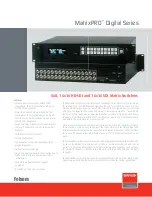
AT-HDVS-210U-TX-WP
11
1.
Determine the proper faceplate to be used for installation. If using the black faceplate, then refer to
Removal and Assembly (page 13)
for information on changing the faceplate.
2.
Connect an Ethernet cable, from the
HDBaseT OUT
port, on the rear of the unit, to one of the following devices.
Ethernet cables should use EIA/TIA-568B termination:
a.
PoE-compatible receiver (not included), such as the AT-HDVS-200-RX. Refer to
Figure 1
on the next page.
b. Atlona Power Over Ethernet Mid-Span Power Supply (AT-PS-POE). Use this option if the system endpoint is
not capable of supplying power to the AT-HDVS-210U-TX. Refer to
Figure 2
on the next page.
Refer to the tables below for recommended cabling when using Altona products with HDBaseT technology.
The green bars indicate the signal quality when using each type of cable. Higher-quality signals are represented
by more bars.
These table are for guidance, only. Performance may vary, based on environmental factors.
Connection Instructions
Core
Shielding
CAT5e
CAT6
CAT6a
CAT7
Solid
UTP (unshielded)
N/A
STP (sheilded)
Performance Rating (MHz)
350
500
600
800
Cable
Max. Distance @ 4K
Max. Distance @ 1080p
CAT5e / CAT6
115 feet (35 meters)
200 feet (60 meters)
CAT6a / CAT7
130 feet (40 meters)
230 feet (70 meters)
Installation
3.
Complete the installation of the AT-HDVS-210U-TX-WP into the electrical box or mudring. Refer to the
4.
Connect a USB-C cable from the
USB-C
port to a UHD/HD source.
5.
Connect an HDMI cable from the
HDMI
port to a UHD/HD source.
6. OPTIONAL: Connect an RS-232 control system to the
RS-232
port on the switcher. This port is used to control
functions of the AT-HDVS-210U-TX-WP, such as volume up/down, display on/off, etc.
No power supply is required for the AT-HDVS-210U-TX-WP. This unit will be powered over the Ethernet cable,
from a compatible HDBaseT receiver.
IMPORTANT:
Stranded or patch cable is not recommended due to performance issues.
Sheilded cables are strongly recommended to minimize signal noise and interference.












































